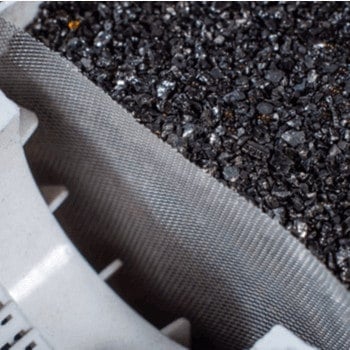
Anyone that has been out shopping for a water filtration system for their home has run into the term “filter media,” without a doubt.
You might be asking yourself, what is it and which is the right filter media for me.
Filter media is simply the material used in a water filter to remove contaminants. There are many different filter media types available, each with its own benefits and drawbacks.
Key Takeaways:
- Activated Carbon: A common form of filtration media, activated carbon works to reduce the amount of organic compounds, chlorine taste and odor, and potentially harmful contaminants.
- Bacteriostatic: Also known as antimicrobial filters, bacteriostatic media can effectively remove bacteria and other microorganisms from water.
- KDF-55: This is a combination of copper and zinc granules that are designed to reduce chlorine, heavy metals, and hydrogen sulfide odors.
- Reverse Osmosis: Is a process that utilizes a semi-permeable membrane to filter out dissolved salts, sediments, bacteria, and other impurities from water.
- Ultraviolet: Is a process used to neutralize microorganisms such as bacteria and viruses in water.
- Catalytic Carbon: This type of filter media uses catalytic carbon to reduce chlorine, taste, odors, and organic contaminants.
- Sediment Filters: Are designed to remove sediment particles such as dirt, rust or other suspended solids from water.
- Zeolite: Is a type of mineral filter media that works to reduce the number of nitrates and heavy metals in water.
In this article, we will take a look at 9 of the most popular filter media types.
What Is a Filter Media and How Does It Work?
Simply put, a filter media is a material used in a water filtration system to remove contaminants. Water passes through the media and can be blocked by smaller particles like sediment and dirt, or can be chemically changed as it comes into contact with activated carbon. The different types of filter media work in their own unique way to trap or change contaminants in the water.
The choice in Filtration media is entirely dependent on the type of chemicals, pollutants, and sediments are in your water source.
How Does a Water Test Determine What Type of Filter Media to Get?
A water test is used to determine the pollutants and sediments in your water source. The test looks for things like pH levels, chlorine levels, total dissolved solids (TDS), and hardness. With this information, they can then recommend a filtration media that will be most effective at removing those specific contaminants from your water.
For example, a high pH level in your water means that you will need an acid-neutralizing filter media. A high chlorine level means you will need a media that can adsorb or remove chlorine from the water. And so on.
Which Type of Filter Media Would I Need For City Water?
If you have public city water, the municipality will most likely have already chosen the type of filter media for your home. In most cases, a granular activated carbon (GAC) filter is used to remove chlorine and other chemicals from the water. However, if you are experiencing any problems with your water, such as bad taste or odor, they may recommend a different filtration media.
See our best rated water filters in 2023
How To Choose The Right Water Filter Media For Well Water?
If you have well water, it is important to test your water to determine the type of contaminants that are present. This will help you to choose the right filtration media for your needs. For example, if your water test shows high levels of iron and manganese, you will need a filter media that can remove those elements from the water. A water test will help you to identify the type of contaminants in your water and recommend a filter media for your home.
What Are The Most Common Types of Water Filter Media:
Now that we have a basic understanding of filter media, let’s take a look at 9 of the most common types.
1. Activated Carbon:
This is one of the most common and effective types of filter media. It is used to remove chemicals, pesticides, and volatile organic compounds (VOCs) from water. It can also be used to remove bad tastes and odor.
Activated carbon media works by a process known as adsorption, which is the accumulation of gas or liquid on the surface of a solid. In water filtration, this means that chemicals and pollutants in your water will attach to the activated carbon granules, which causes them to be trapped in the filter media.
What’s in it?
It’s made from charcoal that has been heated to a very high temperature. This causes the pores in the charcoal to open up which increases its surface area. The increased surface area allows the carbon to attract and trap more contaminants inside of it.
What water filter systems is it used in:
It’s also commonly used in many different types of water filtration systems, such as pitcher filters, faucet-mounted filters, and whole-house filters.
2. Catalytic Carbon
Catalytic carbon is a type of activated carbon that has been treated with a catalyst. The catalyst helps to speed up the adsorption process, which means that it can remove more contaminants from the water in a shorter amount of time.
What’s in it?
Catalytic carbon is made from activated carbon that has been treated with a catalyst. The catalyst is a material that helps to speed up a chemical reaction. In water filtration, this means that the catalytic carbon can remove more contaminants from the water in a shorter amount of time.
What does it filter out over activated carbon?
The catalyst helps to speed up the adsorption process, which means that catalytic carbon can remove more contaminants from water than regular activated carbon. This includes chemicals, metals, and other pollutants.
What are the benefits?
Catalytic carbon has several benefits over regular activated carbon. It can remove more contaminants in a shorter amount of time, and it is also more resistant to fouling. This means that it will stay effective for longer and require less frequent replacement.
3. KDF (Kinetic Degradation Fluxion)
KDF is a type of filtration media that uses copper and zinc to remove contaminants from water. It is a chemical process that breaks down pollutants into smaller, more manageable pieces.
KDF filters out several different contaminants, including harmful chemicals like chlorine, lead, and mercury. It is also effective at removing dirt and sediment from the water. What’s in it? KDF consists of two types of filtration media: copper and zinc. Zinc has a positive charge that attracts negatively charged ions (contaminants).
It is also effective at removing dirt and sediment from the water.
4. Manganese Dioxide
Manganese dioxide is used to remove harmful chemicals like lead, mercury, and arsenic from water. It is an oxidation-reduction reaction (a chemical process) that breaks down contaminants into smaller, more manageable pieces.
Manganese oxide consists of two types of filtration media: manganese dioxide and activated carbon. Activated carbon is a porous, spongy material that helps to remove chemicals and other contaminants from the water.
Manganese dioxide is also effective at removing dirt and sediment from the water. It is a more powerful filter than activated carbon and can remove harmful chemicals that activated carbon cannot. Iron and sulfur can also be removed from the water using manganese dioxide. Well water often contains these contaminants, so manganese dioxide can be a helpful filter for well water.
5. Mixed-Media Filter
A mixed-media filter is a popular choice for many people because it’s a type of water filter that uses several different types of filtration media. This can include activated carbon, KDF, manganese dioxide, and other materials.
The purpose of multi-media filters is to remove as many contaminants from the water as possible. It uses several different types of filtration media and removes contaminants through different methods (for example: adsorption and oxidation-reduction).
6. Reverse Osmosis Membrane
Reverse osmosis (RO) membrane is a type of water filtration system that produces clean drinking water by removing contaminants from the water. It uses pressure to force water through a semi-permeable membrane, which separates the contaminants and recreates clean, healthy drinking water. The RO membrane removes 90% or more of all pollutants and contaminants from the water.
RO systems can reduce more than 99.99% of total dissolved solids (TDS) from water. TDS consists of small particles that contribute to poor-tasting water – read more on what TDS is and how to measure it. They are mostly minerals and salts, including nitrates, lead, mercury, arsenic, fluoride, chromium 6 (a harmful chemical), and other contaminants.
Reverse osmosis membrane are effective at removing these pollutants from the water because they reduce TDS below detectable levels.
The contaminants that are removed by a water filter will usually end up in the wastewater stream. This is the water that goes down the drain after the water has been filtered.
Some water filters (like reverse osmosis) have a wastewater stream that is clean enough to be discharged into the environment without causing any harm. Other water filters (like activated carbon) may discharge wastewater that still has a low concentration of contaminants.
In these cases, the wastewater should be stored in a holding tank and treated before it is discharged into the environment. This helps to further reduce the risk of environmental contamination from water filter effluent.
7. Ultraviolet light (UV Filtration)
Ultraviolet (UV) light is an effective water purification method that uses radiation to kill harmful microorganisms. These microorganisms include bacteria, viruses, and cysts like Giardia lamblia. UV light has been studied as a treatment for wastewater effluent because it does not remove other contaminants from the water. Other types of filtration (like reverse osmosis) remove more than 90% of the contaminants, while ultra violet light only removes microorganisms.
UV light is often combined with other purification methods because it can be expensive to install and maintain. This system is usually an add-on to whole-house filtration systems.
8. Activated Aluminum Oxide (activated alumina)
Activated alumina is a granular material that has been treated with oxygen to create a porous surface. This process removes contaminants from the water by adsorption, creating clean drinking water as the water passes through the filter. Activated alumina is similar to activated carbon in effect, but it can remove fewer contaminants.
This water filter is effective at removing arsenic, aluminum, lead, and other heavy metals from the water. It is also effective at removing chlorine and other chemicals from the water.
Activated aluminum can be used as a standalone filter or in conjunction with other filters like carbon filters.
9. Calcite
Calcite is a type of naturally-occurring, porous limestone. Calcite’s chemical formula is CaCO3 (calcium carbonate). It is sometimes used in water treatment because it can remove excess amounts of calcium and magnesium from the water.
Calcite filters are not effective at removing other contaminants like heavy metals or chemicals. They are only effective at removing minerals and salts from the water.
This type of water filtration media is often used in conjunction with other filters like activated carbon or reverse osmosis. It can be used to improve the taste and quality of the water.
 147 people found this helpful. Was this guide helpful to you?
147 people found this helpful. Was this guide helpful to you? 

